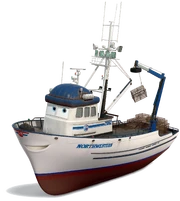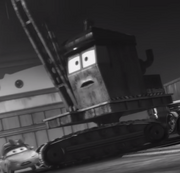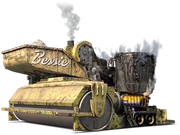Vehicles are the main inhabitants of the world of Cars and Planes, set on a world populated entirely by anthropomorphic vehicles and no humans.
Biology[]
Vehicles come in different shapes, sizes, colors, classes, years, makes, and models. Many have their eyes located on their windshield (as opposed to being on their headlights, which serve as their cheekbones instead, unlike most cartoon vehicles such as like Nickelodeon's Blaze and the Monster Machines of course, Auto B Good, Tayo the Little Bus, Chevron cars, etc.; though there is one exception to this rule). The vehicles' windows are all opaque and gray blanked out, so no one knows what is inside, and it is implied that they may not be hollow (though some concept art imply the presence of animal-like organs inside them). None of their doors ever open (ultimately, the only one exception being Mater in the episode "Salt Fever" of the 2022 series Cars on the Road). Convertibles always have their roofs up, vehicles without a roof in real life (such as Francesco Bernoulli and Rip Clutchgoneski) are given on in this world (technically, their heads are actually a human's helmet, but is not stationary) and vehicles with asymmetrical cockpits (such as Topper Deckington III) in real life have perfectly symmetrical cockpits in the same world. Whenever a car blushes, his/her headlights start turning on at the wrong time or shine brighter if they were already on. Cars typically have four wheels, but some vehicles have fewer like three (such as Tomber), or more like six (such as obviously Mater; he is actually "dual-wheeled", and/or also known as the very popular truck term "dually", which are also with four rear wheels). Vehicles usually treat their front wheels as if they were hands, and use them to move objects, and their tires as shoes. Cars also don't have stated ages but are rather implied. As there are examples of kid cars, multiple adult cars and elderly cars.
Cars do not wear clothing, but some appear to have headgear of some kind (such as semi-trucks having wind deflectors resembling trucker caps), and some other accessory (such as glasses for Mel Dorado, and a monocle for Professor Z). Some characters' names are either references to the type of car they are (Sally (Porsche Carrera), Doc Hudson (Hudson Hornet), Cad Spinner (Cadillac Escalade; although more generic), etc.), a car-related pun (Darrell Cartrip, Nigel Gearsley, etc.), an abnormal first name and a normal surname (Lightning McQueen, Bruiser Bukowski, etc.), either a normal first or full name (Roger Wheeler, Chuck Armstrong, Hank "Halloween" Murphy, etc.), or only having one name, whether real (Fillmore, Sarge, Luigi, Guido, etc.) or unusual (Boost, Ripslinger, Mayday, etc.). Vehicles primarily treat fuel as food, although they can sometimes be seen eating human food like fruits and vegetables as well. It is shown that some cars have religions ("Chrysler" replacing "Christ", "the manufacturer" replacing God, the presence of an automobile Pope, etc.) like some cultures in real-life. Some vehicles are known to actually fall in love (Lightning McQueen and Sally Carrera, Mater and Holley Shiftwell, Dusty Crophopper and Ishani, etc.) and even get married (Ramone and Flo, Uncle and Mama Topolino, Harvey and Winnie, etc.). Even though vehicles can also be children as well as adults, it is unknown of how were they able to reproduce in the first place, although several quotes throughout the Cars series imply that they are manufactured (e.g., a quote/line by Tomber "At least 35,000 cars were made with this engine." and "Beuck! That is the worst motor ever made."). Vehicles can apparently also die like Doc Hudson, Rod "Torque" Redline, Leland Turbo, etc.), though it is left vague on what happens to them post-death if not destroyed already (the Cars deleted scene "Lost" and The Radiator Springs 500½ of Tales from Radiator Springs depicts dead cars as old, broken-down actual cars).
Types of vehicles[]
Ground vehicles are the most abundant type of vehicles in this world. At least four types of vehicles exist: automobiles, trucks (pickups and semis count both), buses, and pitties (forklifts). Cars, trucks, and pitties appear to be the main stand-in for humans, and often tend to do the same things humans do (even much more so for the pitties, due to their smaller size and "lifts" more maneuverable as arms). However, it is unknown of why vehicles like buses and taxis exist in their world if cars obviously cannot fit inside them. Bikes, motorcycles, ATVs and segways do not exist in this world.

Everett, the example of an airplane
Aircraft, spacecraft, trains, boats and ships are typically used as transportation for the cars due to their larger size. Aircraft come in at least three types: planes, helicopters and airships. On some aircraft, they appear to wear either sport goggles or helmets on their cockpits. Most aircraft and spacecraft are large enough for cars to fit inside of, but smaller aircraft act more like individual humans rather than transport. Spacecraft are usually space shuttles or space rockets. Hot air balloons, however, are not anthropomorphized.

Muir, the example of a steam locomotive
Trains are mostly diesel or electric, with some occasional steam locomotives. On steam locomotives, their eyes are located on their front windows behind their boilers rather than on their smokeboxes like the characters in Thomas the Tank Engine. Locomotives usually act like humans, and the number of wheels tend to vary; steam locomotives usually have either zero (or no), two, or four pilot wheels, a varying number of drive wheels, and zero, two, or four trailing wheels, while diesel and electric locomotives have either eight or twelve wheels (four or six on each bogey). Trains and rolling stocks are much larger than in real life in order to accommodate a car. Rolling Stocks are not anthropomorphized.

Crabby, the example of a boat
Boats/ships are the largest of these vehicles and are often either large ships or speedboats. On some ships, their bridges resemble a ship captain's hat. Many boats and ships are large enough to carry a good number of vehicles. A submarine was shown in the end credits of Cars 2, and Skipper Riley mentions German U-boats fighting in WW2 in the comic Stratagem. Rowboats, canoes, and kayaks are not anthropomorphized.

An I.B Haul Crane, the example of a crane
One anthropomorphized machine that is not a vehicle is a large rotating crane shown at the beginning of Finn McMissile's escape from the oil rig in Cars 2.
Animals are also car-ified, either appearing as large machines like tractors (cows and deer), combines (bulls), bulldozers (also bulls), snowmobiles (also deer) though cars can't ride on them, miniature cars (insects, rodents, plus RC/Radio/Remote Control Cars whether in the beginning of Cars 2 somehow cars use their tires with a control to move the joystick that moves the car), planes (birds), or trains (snakes), or giant dump trucks (elephants). A road sign seen in Moon Mater shows a crocodile with tires. Crabby is stated to be a crab boat who fishes for crab out of the Bering Sea, and Fireball Beach in Florida is classified as a crab sanctuary, at which Cruz Ramirez stopped to avoid hitting one. Other than these, no other animals are known to exist in this world. Because of this, it is unknown if human versions of large machines exist, and there must be a way for crops to be harvested, structures to be built, and where vehicles usually get meat for food. Some logos appear to have un-car-ified animals (such as the Dinoco logo and the Ferrari logo) despite this. Additionally, there is a picture of the Jackalope from Boundin', plastic flamingos, and the birds from For the Birds, all of which are un-car-ified, as well as a bumblebee from the Cars 2005 Teaser Trailer, and the bear on Sacramento's flag. Plants like trees and bushes are not carified like the animals, but flowers resemble taillights of old cars. This may be due to vehicles treating plant life as if they were a fuel source.

Bessie, the example of a non-anthropomorphized vehicle
At least one machine, Bessie, is not anthropomorphized at all.
Notes and references[]
- © Disney/Pixar; rights in underlying vehicles are the property of third parties, as applicable: AMCTM; AndrettiTM; ApeTM; BentleyTM; BMWTM; CadillacTM; ChevroletTM; CorvetteTM; Dodge®; El DoradoTM; FairlaneTM; Ferrari®; FIATTM; GremlinTM; Hudson HornetTM; HummerTM; IVECO®; Jeep®; Kenworth®; Land RoverTM;©TM 2012 LTI LTD; MackTM; MajestaTM; MaseratiTM; Mazda MiataTM; MercuryTM; MINI CooperTM; Model TTM; Ford, MondeoTM; Monte CarloTM; MustangTM; PacerTM; OPEL, VAUXHALL, ASTRA, CORSA, MERIVA and ZAFIRA are registered TM of Opel Eisenach or affiliates; Peterbilt®; PettyTM; PeugeotTM; Plymouth SuperbirdTM; PontiacTM; PorscheTM; Range RoverTM; TatraTM; TopolinoTM; ©Volkswagen AG[1]
